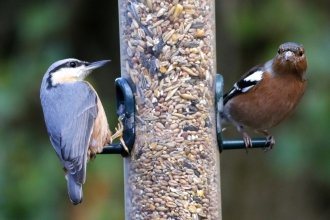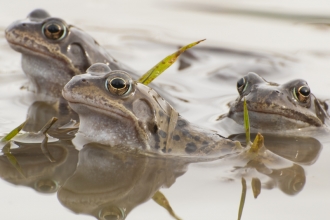Since World War II we have lost 160,000 km hedges due to intensive farming
Planting a hedge
Native hedges add valuable shelter to your garden and it is one of the first things you should consider planting in your wildlife area.
The best hedges for wildlife are thick with a range of woody species such as hawthorn, blackthorn, field maple, hazel, spindle, wayfaring tree and wild service tree occasionally overtopped by oak, ash and other standards (sometimes pollarded).
Since World War II we have lost 160,000 km hedges due to intensive farming which has undoubtedly contributed to the decline of Britain’s wild bees, butterflies, hedgehogs, birds etc.
So, do plant a hedge to provide a valuable habitat for our wildlife.
How to plant a hedge
Hedges can be planted in single or double rows. If you only have space for a single row hedge you will need about three trees per metre. Leave enough space for your hedge to bush out.
For a double row hedge you will need 6 trees per metre. Mark out the rows about 50-60 cm apart and plant in an off-set pattern. Plant a double row hedge if you have space.
Native hedge trees are best (and cheapest) planted as bare-root whips during the winter months. These can be planted quickly by making a simple slit with a sharp spade and sliding in the plant at the back of the spade.
When to plant a hedge
Bare-root or root ball planting
-
Plant deciduous hedges in autumn or winter, Nov-Feb
-
Don’t plant if soil is waterlogged or frozen
-
Evergreen or semi-evergreen hedges in early autumn, but can be planted Oct-Feb
-
Plants in pots can technically be panted any time of year but the autumn/winter months are best for success
Give your hedge a chance
It is a very good idea to put down some mulch; either plant though a weed membrane and add wood bark on top or just put a thick layer of wood bark around the trees.
The young trees need to get established before becoming swamped by tall grasses and other weeds.
Don’t forget to water your newly planted hedge and through periods of dry weather.
Native hedging plants
Hawthorn, hazel, holly, spindle, crab apple, field maple, beech, blackthorn, dog rose, dogwood, elder, field and dog rose, honeysuckle (as an addition to other plants) guelder rose, wayfaring tree, wild service tree, wild privet and oak – some could be left to grow to big trees if possible
Non-native hedging plants
Berberis, Escallonia and Pyracantha are not native but they make good hedges rich in nectar and full of berries.
Maintenance
In order for a new hedge to bush out it needs to be trimmed every year, apart from the year of planting.
If you are cutting your hedge every year, make sure you are doing it during the winter months before the bird nesting season.
Once your hedge is established, one of the best way to manage it for wildlife is to lay it. Hedge laying is best carried out in late winter, before the nesting season and when most berries have been eaten.
Planting a tree
Trees add interest and structure to your garden. If your garden is small you have to think carefully what trees to use and where to plant them. Avoid shading your nectar border or planting them too close to your pond.
How to plant a tree
Dig a generous sized hole for your tree and if the soil is poor, add some home-made compost or well-rotted manure when planting. Make sure the trees are planted deep enough and firm them in carefully by stamping the soil afterwards. Trees do not like ‘rocking in the hole’. If your trees are in pots, make sure the final soil level is the same as in the pot.
Avoid using stakes unless it’s a very windy site. If you stake them, stake them low and make sure your tree can’t rub on the stake. Put the stake up-wind of the tree so it leans away from the stake. Use a rubber tie (old bicycle inner-tubes are good). Importantly: remember to loosen the tie round the tree as it grows older and the trunk gets bigger. If you aren’t able to check on ties/stakes it’s probably better not to stake them. Too many planted trees are damaged from bad staking.
Remember to water well until it is established!
Medium sized trees
Birch, bird cherry, crab apple, elder, field maple, guelder rose, hawthorn, hazel, holly, rowan, spindle, willow and fruit trees.
Large trees
Oak, wild cherry, ash, alder, beech, wych elm, small leaved lime, yew
Plants for hedge and woodland edge
Betony, bird’s foot trefoil, bluebells, bugle, common cog violet, dog’s mercury, foxglove, garlic mustard/Jack-by-the-hedge, herb robert, greater stitchwort, hedge woundwort, honey suckle, ivy, lesser celandine, red campion, snowdrops, stinking hellebore, sweet Violet, sweet woodruff, wild garlic, wood anemone, yellow archangel.
Climbing plants for fences and walls
These provide food and shelter for a wide range of animals.
Ceanothus, climbing hydrangea, ivy, hops, honeysuckle, clematis, rambling roses (dog and field), quince, Russian vine, Pyracantha,





